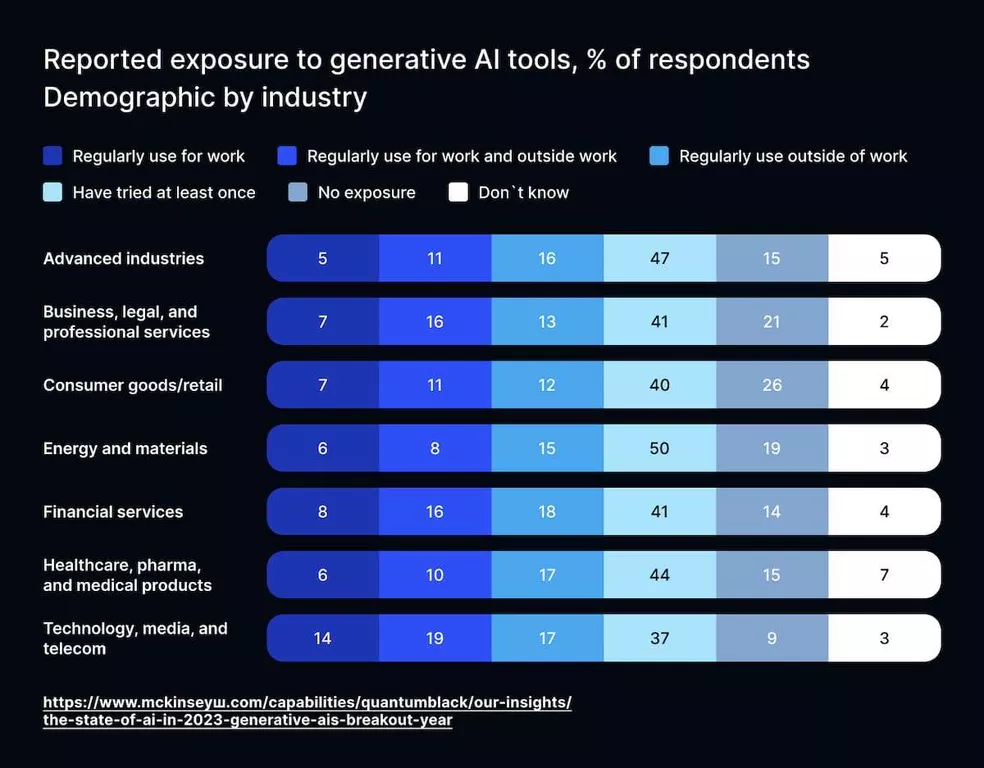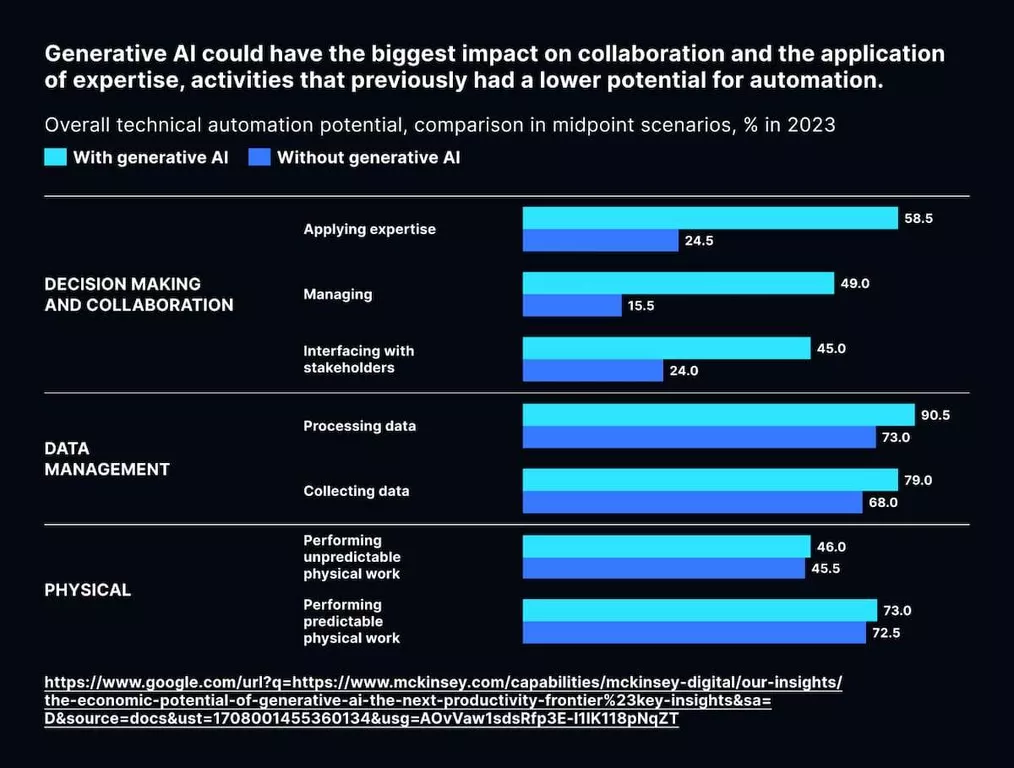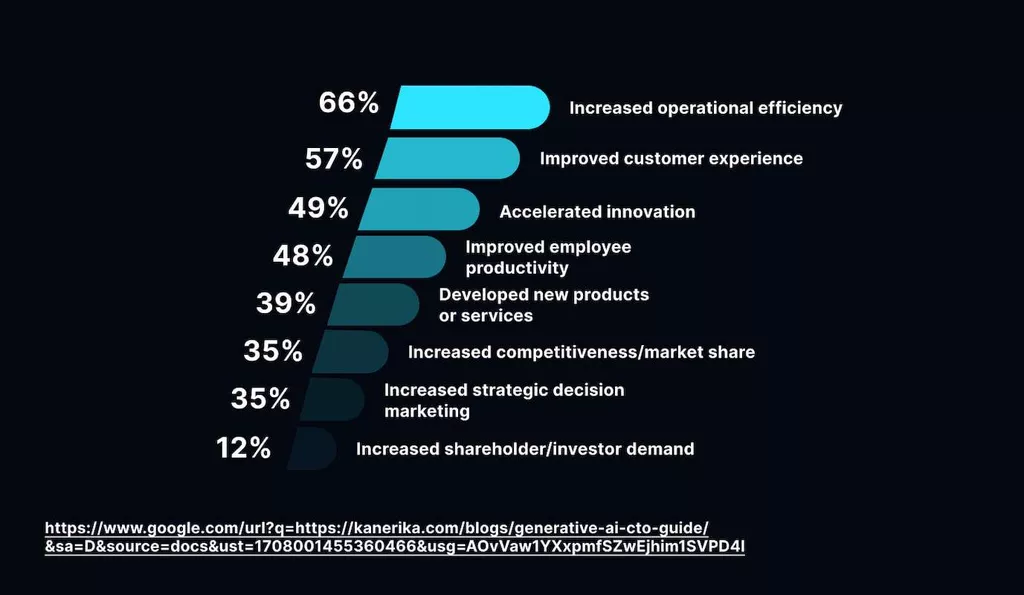Breakthrough discoveries frequently make news in the rapidly evolving field of generative AI. McKinsey reports that it may add between $2.6 trillion and $4.4 trillion annually. However, it’s critical to learn from previous technology revolutions, like the internet and mobile, that a lot of work should be done to transform early excitement into significant commercial advantages. Tech leaders, like CIOs and CTOs, play a huge part in unlocking the full value of this potential.
With the rise in gen AI, CIOs and chief investment officers now have a unique chance to put all their knowledge into practice by helping the C-suite realize generative AI’s potential and create long-term value in the company. In our generative AI guide, we’ll look into gen AI and offer best practices of using it in your organization.
What Is Generative AI?
Artificial intelligence that emphasizes the creative potential of algorithms is known as gen AI. Traditional systems carry out tasks according to preset rules. Conversely, generative AI enables machines to produce novel and remarkable content.
And when it comes to these models, they dive deep into massive datasets that are filled with examples of what they’re trying to create. We’re talking about all sorts of things — music, photos, writing, you name it. They soak it all in to bring out something fresh and artistic.
As generative models take in this data, they scrutinize the links, patterns, and subtleties that are present in it. They study the formation of sentences from words, the harmony of musical compositions from notes, and the creation of visual masterpieces from brushstrokes. Neural networks mimicking the human brain’s intricate workings facilitate this learning process.
McKinsey states that currently, 22% of professionals actively use generative AI in their jobs, while 79% have encountered it.

So, let’s dive into some innovative ways people are using generative AI:
- crafting the first content drafts for marketing;
- planning product development to analyze consumer patterns;
- jumping in to help with technical support, making client connections more seamless.
You might have heard about ChatGPT. It stepped into the scene in late 2022, and now big players like Microsoft, Google, and Amazon are taking advantage of it. In 2024, generative AI for business is gearing up for serious upgrades. Companies are even thinking about offline device functionality. As an illustration, Intel works on a processor to operate chatbots powered by generative AI offline.
The CIO and CTO are essential to advance team skills in gen AI. Their duties include creating policies, determining CIO AI use cases, and formulating strategic objectives. Cooperation with data scientists and funding for training initiatives are crucial in development and implementation to be effective. CIO and CTO have a great burden on their shoulders. They have to:
- Ensure data is accurate and complete.
- Keep an eye on security and performance.
- Keep up with technological advancements.
Creating an innovative culture which promotes experimentation and ongoing development is likewise essential. Under the direction of the chief technology officers and CIO, this all-encompassing strategy presents generative AI as a business-transforming force. It empowers teams to explore and push the envelope of possible outcomes.
Why Is Generative AI Important?
Gen AI and LLMs have shown an intriguing potential to revolutionize nearly every business’s current workflows. Companies stand to gain financially from significant cost reductions if they drastically alter their processes. They may refuse human labor and add automation to critical functions. Because it’s transforming many fields, generative AI is indispensable:
- Amping Up the Onboarding Process: Service desks driven by gen AI can automate the onboarding of new hires. As a result, work is streamlined, and new personnel may finish procedures independently. It guarantees a seamless and effective onboarding process. You can say goodbye to delays and say hello to raising employee satisfaction levels.
- Unleashing Creative Power: Gen AI is like a robust assistant for businesses. It helps them churn out loads of creative and captivating content. Take the advertising game as an illustration. AI-driven systems whip up attention-grabbing ad copy, eye-catching visuals, and even video content. It becomes a handy tool for innovative ideas and cuts down on the heavy lifting of manual creative work.
- Boosted Efficiency: Gen AI lets firms automate those tricky and time-consuming tasks. They fine-tune workflows and use resources like pros. AI algorithms roll out top-notch production schedules in manufacturing, cutting waste and maximizing efficiency. In contact centers, it steps in to help out customer support agents.
- Getting Insights from Data: Generative AI models have a knack for diving into different datasets. It gets loads of data and presents some valuable insights. Take finance as an example. AI dives into market trends, consumer actions, and economic signs to build predictive models.
- Flexible Learning: Gen AI systems are perpetual learners of the tech world. They keep soaking in feedback, new data, and get better with time. Let’s look at education as an example. AI models adjust learning materials and methods to match each student’s unique needs, preferences, and learning styles. Therefore, it’s easier to revamp the effectiveness of educational experiences.
The importance of generative AI encompasses its revolutionary effects on creativity, automation, and problem-solving in various fields. Now, talking about unique solutions, MetaDialog steps into the scene. It provides a custom Language Model (LLM) based on your custom data. This cutting-edge LLM demonstrates exceptional contextual comprehension, multilingual skills, and performance thanks to its bespoke data training. Our LLM is designed to deliver real-time replies and a dynamic, tailored conversational experience. It is deployed on-premises for optimal security. Moreover, it ushers in a new age of conversational AI. We meet specific organizational requirements through tailored training on particular data.
How to Integrate Generative AI
Integrating generative AI into your operations is a strategic move that requires a thoughtful approach. What steps can you take to manage risk, scale solutions, coordinate data and technology, and create value for gen AI? To successfully harness the potential of cutting-edge technology, consider the following steps.
Evaluate the company’s position regarding the adoption of gen AI
CIOs and CTOs control risks and limit employee access to gen AI. Nevertheless, it might impede innovation and skill development. Teaming up with risk management specialists to figure out how to implement the basic practices from the generative AI guide is a better move. If you strike the right balance between cutting down risks and honing skills, you set the stage to a successful strategy. It makes it possible to build company-wide rules quickly.
CIOs and CTOs should make rules known and provide clear instructions. Effective tactics involve pop-up alerts of internal data entry, focused user group access, and company-wide messaging. Moreover, create guidance pages for publicly accessible gen AI services.
Boost productivity: Uncover valuable applications
Steering clear of the all-too-common “death by use case” pitfall in generative AI requires the expertise of CIOs and CTOs. They work with executives in the business world to evaluate how the tech adds value and upends current models. Leveraging their tech know-how, CIOs and CTOs pinpoint golden opportunities and challenges aligning well with AI applications.
According to McKinsey’s findings, deploying smart bots in customer care could skyrocket productivity by up to 400%. At the same time, certain marketing applications — like diving into unstructured consumer preference data — could see a boost of about 10%. They produce resource and feasibility estimations, prioritizing according to talent and skill limitations.

Pick the right AI technology
When incorporating AI, companies set out on an important quest to find the best tools. The choice affects long-term success. It necessitates carefully analyzing AI technology which might support business objectives. The selected tech should take into account future scalability as well as existing demands.
Assess cost, performance history, simplicity of integration, and dependability of the chosen tech. It’s frequently essential to perform comparative evaluations and consult with industry specialists. When choosing, the main focus should be on how the tech can bring real, measurable value to the table. It should let businesses tap into the power of AI and shake up their processes.
Guide through the challenges of AI
Businesses may encounter difficulties when utilizing AI capabilities. They range from issues with real-time data complexity and IT infrastructure quality to data security and labor scarcity. Neglecting to acknowledge and tackle these obstacles may result in money losses. It leads to disturbances to operations and data privacy violations. Overall, it affects the organization’s efficiency and standing.
In this case, the CIO’s function is quite essential. CIO takes technological limitations into account. Moreover, they must recognize probable obstacles and develop workable mitigation plans. They also need to evaluate the preparedness of the IT infrastructure, handle cybersecurity risks, and guarantee regulatory compliance. With the help of thorough study, you can put safeguards and monitoring systems in place to ensure a smooth transition to the effective use of AI.
Harness AI potential through efficient data management
Sustaining data quality is indispensable in the effective use of AI in the complex world of technology. It entails cleaning, converting, and customizing data to guarantee accuracy and relevance to predetermined goals. Strong data management includes collecting, storing, using, and protecting information. It’s the cornerstone of AI implementation. Strict administration ensures consistency, ease of use, and security. They are essential to the ongoing functioning of AI systems. CIOs need to give careful data management and data quality maintenance top priority if they want to take full advantage of gen AI.
Setting up efficient AI oversight
For gen AI to work as desired, nailing down clear assessment measures is a must. Especially when we’re talking about AI techniques like chatbots in customer support, keeping tabs on metrics like customer satisfaction, problem resolution, and speedy responses is key. Understanding the full scope of AI use in a company hinges on precise assessment.
Organizations need to make quick adjustments if performance is below expectations. It’s critical to have a CIO with experience in AI and rapid decision-making abilities based on evaluation criteria. Artificial intelligence has the potential to completely transform an organization’s operations with careful examination and prompt response.
Sustaining AI impact
A business must guarantee continuous impact and move beyond the initial installation of AI to reap long-term advantages. It necessitates the ongoing analysis and improvement of AI applications, systems, and methods. It takes proactive steps and ongoing attention to detail to solve problems quickly. Therefore, implementing consistent training initiatives and cultivating an AI-focused atmosphere inside the company expedites advancement. It guarantees the enduring influence of AI.
Real Examples of Generative AI
GenAI is a standout team player. It flexes its versatility and effectiveness across a scope of commercial applications. AI is a game-changer in different industries and sectors. It’s not just about making things run smoother. It’s about cracking open doors to all sorts of new possibilities. As part of our generative AI guide, let’s dwell on various commercial applications of gen AI.
- Coca-Cola introduced the “Masterpiece” campaign. It enhanced marketing using DALL.E and ChatGPT. The campaign animated famous artworks to make an immersive customer experience with the help of genAI.
- Mastercard integrated ChatGPT into its chatbot platform. Now, it presents a virtual assistant which goes beyond traditional features. Analyzing customer behavior provides tailored advice and makes comprehensive financial analysis easier.
- Any health app may tap into the power of AI to give patients and doctors some expert medical advice through a chatbot. Check out Google’s Med-PaLM. The AI model may offer detailed answers to all sorts of health questions. It might even write up solid summaries after going through tons of medical info. The LLM trained on medical stuff has been given the nod by real medical pros. The doctors at Mayo Clinic are giving Med-PaLM a test run, saying it’s got potential.
- Shopify incorporates ChatGPT into its Shop software to simplify the lives of online business owners. It answers questions and helps with content generation. The store owners might easily create blogs that are optimized to search engines, emails that are interesting to read, and compelling product descriptions.
These industry leaders demonstrate the revolutionary power of GenAI. It remarkably reshapes and enhances numerous elements of corporate operations and consumer interaction. Google’s research notes that a noteworthy majority of companies utilizing GenAI — 66% of them — reported increased operational efficiency. An even more remarkable 57% mentioned improved customer experience. In addition to these successes, over half of the firms polled reported a significant improvement in staff productivity, and 48% reported a rise in creativity.
This data depicts GenAI as a transformative force. It’s changing the corporate scene through increased productivity, improved customer experiences, and encouraged innovation inside businesses.

Tips and Reminders for Using Generative AI
Generative AI has ushered in a profound revolution. It fundamentally reshaped our perspectives on creativity, problem-solving, and automation. In light of this paradigm shift, navigating the vast terrain of gen AI requires a mindful approach. Remember the following suggestions to make the best use of the technology:
- Create a brief AI strategy guidebook. Outline your goals, potential advantages, risk analyses, KPIs, and best practices of generating value.
- Find sponsors to fund AI initiatives. Ensure their KPIs are measured precisely and widely shared.
- Invest in data literacy initiatives to foster a data-driven culture. Give your staff the tools they need to manage and make sense of the abundance of data at your disposal.
- Make ethical AI practices a priority and not just an afterthought. Include them as core components of your AI strategy. It helps to build AI technology responsibly and sustainably while also protecting against possible risks.
When applied effectively, generative AI may encourage innovation and improve problem-solving in various fields. It works well in data augmentation, automation, and content generation. But to ensure that technology works for you and complements your goals, you must use it sensibly and intelligently.
Wrapping Up
To sum up our generative AI guide, the development of CIO and CTO positions signifies a radical change from traditional duties to strategic alliances. Their impact goes beyond ensuring the tech infrastructure functions properly. AI is at the vanguard. Therefore, this transition is evident in their crucial role in forming company strategy. CIOs and CTOs make important decisions about AI deployment strategies, risk management, and AI tech selections.
They actively encourage the development of AI-related skills and know how to effectively handle the changes that come with such revolutionary technology. For forward-thinking AI enterprises seeking innovation, MetaDialog generative AI services present an unparalleled solution. It’s a multilingual, secure solution that effortlessly integrates with tools and software. It helps organizations move toward a future where AI and strategic alliances work together to create unmatched opportunities. With the help of MetaDialog solutions, take the risk and open up new opportunities in your company.
